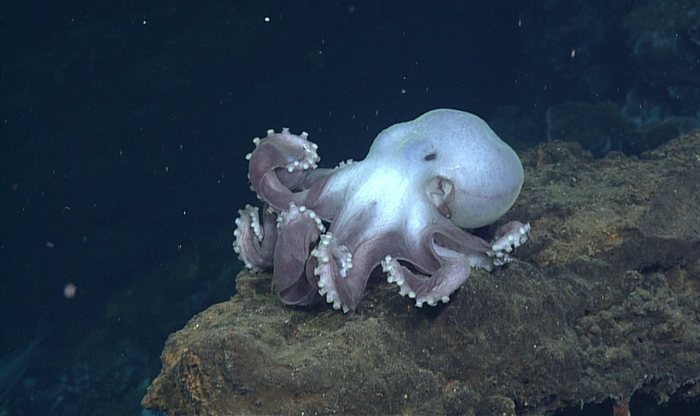Axial Seamount Biology Catalog Live

A Graneledone Octopus ignores ROPOS at El Guapo hydrothermal vent on Axial Seamount’s caldera. Photo credit: NSF-OOI/UW/CSSF; Dive R1723; V14
The Axial Seamount Biology Catalog is a collection of stunning video and still imagery obtained during the Construction and Operation and Maintenance phases of the National Science Foundations’ Regional Cable Array spanning 2011 to 2016. The catalog currently contains 39 unique faunal entries, 63 videos, and 62 images.
The project was initially created by undergraduate student participants onboard R/V Thompson during the UW-NSF Ocean Observatories Initiative (OOI) VISIONS’14 construction cruise in 2014. The students set out to create a resource for scientists and community members to utilize for identification of organisms at Axial Seamount. The students also wanted to create a resource for interested viewers watching video streamed live during the cruise.
During transits to the seafloor with remotely operated vehicles (ROV), organisms are commonly observed during dives or as they interact with the equipment/ROV. These cruises are dominantly focused on engineering (getting the Cabled Array infrastructure and sensors on and off the seafloor), so the scientists onboard the cruises rarely focus directly on the animals and onboard staffing does not include a dedicated biologist. Therefore, the students set out to create this resource for the community.
The students combed through hours of old high definition video and video as it was collected in 2014 and complied this imagery with still photos and information from the Internet about each observed animal. This project was initiated by students on the first leg and was eventually taken up by students on all seven legs of the VISIONS14 cruise. Follow-on work on the catalog was done by undergraduates on the VISIONS’15 cruise in 2015. In total 8 undergraduate students, have worked on the project with backgrounds in oceanography, biology, engineering, and marine biology.
The hope for the project is that it will constantly be improving as more imagery is collected during the OOI’s lifetime and through contribution by scientific experts, students, and the community.
For more information, check out the OOI Cabled Array’s Interactive Oceans Website.
